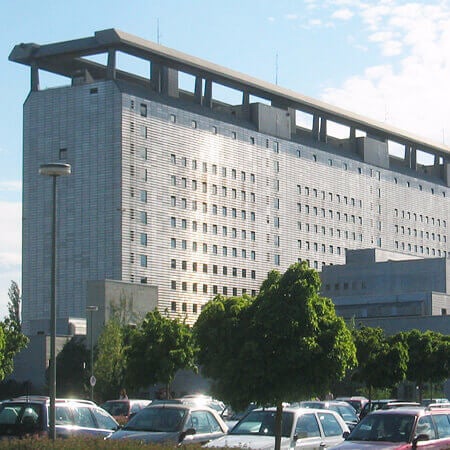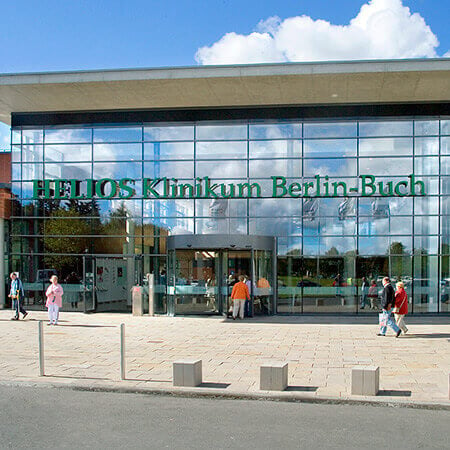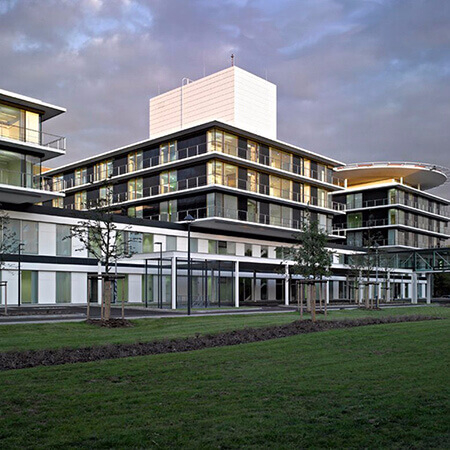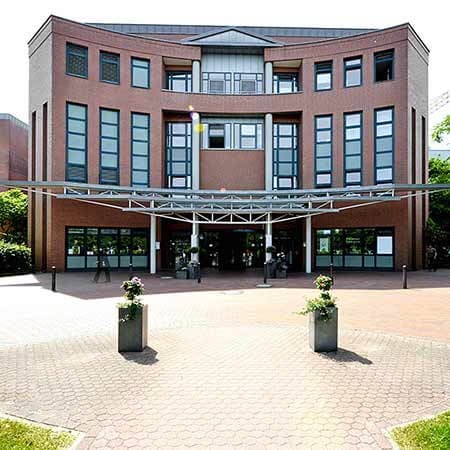Melanoma
Melanoma is one of the most widespread malignant tumours among patients under the age of 30. The rate of this disease is constantly growing worldwide. The number of patients with melanoma doubles every 10 years. Though this tumour is responsible for about 1% of skin diseases, the mortality of the patients is much higher than from the other types of skin cancer.
The Booking Health portal presents 48 German clinics specializing in melanoma treatment
Show all clinics
Melanoma – Diagnostics
Melanoma must first be suspected and then diagnosed. Often, melanoma doesn’t differ from the usual mole or nevus. That’s why a person’s medical history is the key for the primary diagnostics.
7 criteria that are characteristic for malignant skin formation are listed below:
- Size change (mole’s growth)
- Form or borders change
- Colour change
- Inflammatory process (swelling, redness)
- Bleeding or scab formation
- Sensitivity change (soreness of the mole or numbness in its area)
- The diameter of the formation is more than 7 mm
Additional clinical signs that help a doctor to diagnose melanoma are:
- Disappearance of skin picture in the area of pigment spot
- Skin peeling
- Hair loss
- Thickening
- Enlargement of the regional lymph nodes
The following instrumental examination methods help to establish the diagnosis:
- Dermatoscopy means that a formation is analysed at magnification of several tens of times. Method doesn’t give a chance to confirm the diagnosis.
- Cytology is rarely used. Fine-needle aspiration biopsy of the malformation is not performed at all, as it can contribute to the spreading of tumour. Cytological examination is performed only in case of ulceration of melanoma (smears-prints). Also, biopsy sample of the enlarged lymph node can be examined.
- Histological examination is the main method which allows to confirm the diagnosis. An excisional biopsy is performed and the suspicious malformation is completely removed. Then a histological examination is performed. Thus, diagnosis of melanoma is confirmed and a type of tumour is identified.
- Optical biopsy is the latest diagnostics method that diagnoses melanoma without intervention. It is the most valuable for patients with a large number of the suspicious formations on the skin. Method of reflective confocal microscopy enables tissue examination without its separation from the body.
- Imaging methods are used to identify metastases. Chest x-ray, ultrasound of the abdomen, computed tomography and magnetic resonance imaging, bone scintigraphy and other examination methods are performed.
Best clinics for the melanoma diagnostics in Germany:
Melanoma – Treatment
Surgery is often considered as the main type of treatment. Excisional biopsy is performed during the diagnostics stage, with 0.5-1 cm of healthy tissue completely removed. Histological analysis is immediately performed to confirm the diagnosis, then the extent of the surgery is determined.
Melanoma is removed along with the healthy tissue (surgeons recede 3-5 cm from its edge on the limbs or body, and 2-3 cm on the face), subcutaneous tissue, and fascia or aponeurosis. If there are major defects that cannot be fixed by contraction of the wound edges, then microsurgical autoplasty is performed using the patient’s own skin flaps. If melanoma is located on the protruding part of the body, for instance finger or ear, then it will be removed completely.
In addition, chemotherapy, immunotherapy and targeted therapy are used. The treatment regimen depends on the stage of the illness. Radiation therapy is rarely used unless the disease is at an advanced stage and palliative treatment is required.
Melanoma – Innovative treatment
New treatment techniques are constantly being developed that significantly increase the patient’s life expectancy.
Among the latest techniques are:
Immunotherapy with dendritic cells. Dendritic cells are taken from the patient’s own blood. These are the basic antigen-presenting cells of the body. They are stimulated by the tumour cells in the laboratory conditions and then are injected back. As a result of treatment, the immune system reacts to the malformation cells more actively.
Melanoma vaccine is a method of immunotherapy when the substance is injected into the body and causes the immune system to fight melanoma more actively. Nowadays, the vaccine containing received from melanoma cells antigens is being clinically tested. It is not implemented into the clinical practice for now.
Targeted therapy. There are medications for melanoma that selectively fight against the tumor cells without affecting the healthy tissues.
The following medicines are used:
- “Zelboraf” and “Tafinlar” are the medicines that destroy cells with BRAF-genes mutations (this gene is mutated in 50% of patients)
- “Mekinist” and “Cotellic” are the medicines that are directed at the MRP proteins (they are located on melanoma surface)
- Imatinib, Dasatinib, Nilotinib impact on cells with mutations in C-KIT genes (these melanomas are usually detected under the nails, on the hands and feet)
Control points inhibitors. The tumour protects itself from the immune system due to the signalling molecules on the cell surface. They are called control points. Substances that “turn off” these points are injected into the patient’s body and thus, enable the person’s immune system to attack the tumour. Pembrolizumab, Nivolumab, Ipilimumab are used to achieve this purpose.
Immunotherapy for melanoma
Melanoma is one of the most immunogenic tumors. Immunotherapy for this disease is very effective. In terms of contribution to the treatment of this disease, it is in second place after surgery. Doctors in developed countries use many methods of immunotherapy for melanoma at stages II-IV. Some methods can cure the disease even at an advanced stage.
Below are the main options for immunotherapy for melanoma:
PD-1, PD-L1, CTLA-4, and LAG-3 inhibitors. According to their mechanism of action, all of these drugs are classified as immune checkpoint inhibitors. They prevent the tumor from evading attacks from the immune system.
Interleukin-2. It is a cytokine that enhances the immune response. The drug has been used less frequently in recent years due to the introduction of new medicines. It can be used systemically or injected into the tumor, depending on the stage of the melanoma.
Oncolytic virus. Imlygic (T-VEC) is injected into the tumor once every two weeks. Despite its local application, this virus also shrinks metastatic tumors due to the enhancement of the immune response.
BCG. The drug can be injected into the tumor. In recent years, it has been rarely used.
Imiquimod (Zyclara). This is a cream that is applied to the skin. This can cure stage 0 melanoma and is also used to suppress intradermal metastases in advanced stages.
TIL therapy. Lymphocytes are taken from the tumor. The most aggressive toward the tumor are selected, multiplied, and administered into the body. This is a technically complex treatment method used at specialized centers.
Dendritic cells for melanoma
Dendritic cell (DC) therapy is a type of immunotherapy. So far, dendritic cell-based vaccines are not standard drugs for melanoma treatment but are used as part of clinical trials.
The essence of dendritic cell-based vaccines for melanoma is that monocytes are taken from a person's peripheral blood, DCs are collected from them, activated with tumor antigens, and injected back into the body. Dendritic cells are usually administered subcutaneously. They enter the lymphatic system, meet T cells, present them with tumor antigen, and thereby activate the antitumor immune response.
Dozens of methods for the treatment of melanoma with dendritic cells have been developed and are undergoing preclinical and clinical studies. Most drugs are autologous DCs activated by peptides or tumor lysates. Such vaccination is rarely used as a stand-alone method because a response to the injection of dendritic cells is achieved only in 10-20% of patients. They can dramatically increase the effectiveness of immune checkpoint inhibitors, so they are usually used in combination with these drugs.
We also recommend that you watch the video on our YouTube channel "Booking Health", where the leading specialists of the specialized clinic talk about the advantages and peculiarities of dendritic cell therapy.
Best clinics for the melanoma treatment in Germany:


Melanoma – Rehabilitation
Most patients require rehabilitation after the treatment of complex oncological diseases. It includes the following aspects:
- Prevention of complications that may occur as a result of treatment. It can be pneumonia, lymphostasis, thromboembolic or infectious complications.
- Restoration of general health. The elimination of the consequences after surgeries and chemotherapy is carried out. The functions of internal organs are restored with the help of various medical and rehabilitation measures.
- Restoration of occupation. A person must not just stay alive. He must have physical and intellectual capabilities, which are sufficient for employment.
- Psychological support. First of all, it is required for patients, whose occupational performance was harmed because of the disease. Patients with deterioration of appearance also will benefit from psychological help.
- Restoration of appearance. If necessary, you can use surgical and other methods in Germany to restore appearance defects caused by cancer. For example, to carry out the reconstruction of the breast.
- Social and domestic rehabilitation. A person with reduced workability is trained to act in the society and perform everyday tasks in new conditions.
In German clinics, rehabilitation is carried out in a comprehensive manner. The patients are provided with qualitative care here. Doctors' monitoring and conservative treatment allow to avoid complications, which usually happen after treatment of oncological diseases. Psychotherapy, physiotherapy and physical therapy are actively used in Germany.
Specialists in different medical spheres take part in the rehabilitation process. These are massage therapists, speech therapists, specialists in physiotherapy exercises, physiotherapists. Social and occupational therapy is carried out, as well. If necessary, people are taught how to eat properly, take care of a colostomy or urostomy, etc.
In Germany, rehabilitation is carried out with the maximum level of comfort for the patient. A person feels the results quite quickly and it improves his motivation and promotes further recovery.
Best clinics for oncological rehabilitation in Germany:
Authors:
The article was edited by medical expert, board certified Dr. Nadezhda Ivanisova. For the treatment of the conditions referred to in the article you must consult a doctor; the information in the article is not intended for self-medication!
Sources:
National Center for Biotechnology
European Society for Medical Oncology
The cost of services includes
Here you can find the cost of treatment for this disease at the German University Hospitals. Leave a request and we will provide a free consultation with a doctor and will start organizing the whole treatment process.
The program includes the following:
- Issuing of an invitation for getting a visa for treatment as quick as possible
- Fixing an appointment at a time convenient for you
- Preliminary organization of a comprehensive examination and discussion of the forthcoming treatment plan
- Arranging transfer from the airport to the hospital and back to the airport
- Provision of interpreting services and services of a personal medical coordinator
- If necessary, assistance in the organization of further surgical treatment
- Provision of a medical insurance against treatment complications covering up to 200,000 euro
- Preparation and translation of medical records and recommendations from the hospital
- Assistance in the subsequent communication with your attending physician, including consultations on repeated X-ray images through the unique medical document management system E-doc




